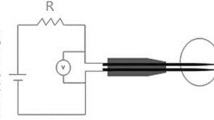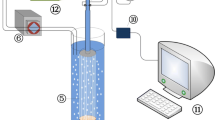Abstract
Exploring a rapid, reliable, and practical means to detect blockages and leakages in liquid pipelines and accurately locate their positions is of great importance in practical engineering applications. Here, we report a bubble motion-based triboelectric sensor (BM-TES) for detecting and locating the blockages and leaks inside a plastic tube. This simple-designed, environment-friendly, non-damaging sensor is composed of several ring-shaped Cu electrodes distributed on a polytetrafluoroethylene tube. The self-powered movement of the bubble under the action of buoyancy makes the inner wall of the tube change from the original solid-liquid phase to the gas-solid-liquid phase, which results in a short-term contact and separation between the liquid and the wall. Based on the fractional triboelectric effect of the liquid-solid contact, an obvious real-time stable voltage peak will be generated where the detection bubble passes. The obvious peaks of the open-circuit voltage with respect to time correspond with the electrode distribution. Then, the peaks can be utilized as a robust and sensitive indicator for detecting blockage and leakage, as the number of obvious peaks of the open-circuit voltage is directly related to the blockage and leakage location. The blockage and leakage in a fluid tube were successfully detected using the BM-TES with an accuracy of 10 cm. In addition, the BE-TES was able to detect the water flow velocity in the pipe. The experimental results showed that BM-TES can provide a new strategy and method for liquid tube monitoring and has great potential application value in related fields.
Similar content being viewed by others
References
Puust R, Kapelan Z, Savic D A, et al. A review of methods for leakage management in pipe networks. Urban Water J, 2010, 7: 25–45
Datta S, Sarkar S. A review on different pipeline fault detection methods. J Loss Prevent Proc Industries, 2016, 41: 97–106
Chu J, Yang L, Liu Y, et al. Pressure pulse wave attenuation model coupling waveform distortion and viscous dissipation for blockage detection in pipeline. Energy Sci Eng, 2020, 8: 260–265
Ito Y, Heydari M, Hashimoto A, et al. The movement of a water droplet on a gradient surface prepared by photodegradation. Langmuir, 2007, 23: 1845–1850
Jafari R, Razvarz S, Vargas-Jarillo C, et al. Blockage detection in pipeline based on the extended Kalman Filter observer. Electronics, 2020, 9: 91
Li X, Liu Y, Liu Z, et al. A hydrate blockage detection apparatus for gas pipeline using ultrasonic focused transducer and its application on a flow loop. Energy Sci Eng, 2020, 8: 1770–1780
Zhang X, Dong Y, He Z, et al. Efficient gas transportation using bioinspired superhydrophobic yarn as the gas-siphon underwater. ACS Appl Mater Interfaces, 2020, 12: 18174–18181
Zhang X, Zheng Y, Wang D, et al. Liquid-solid contact triboelectrification and its use in self-powered nanosensor for detecting organics in water. Nano Energy, 2016, 30: 321–329
Wang Z L, Song J. Piezoelectric nanogenerators based on zinc oxide nanowire arrays. Science, 2006, 312: 242–246
Fan F R, Tian Z Q, Wang Z L. Flexible triboelectric generator. Nano Energy, 2012, 1: 328–334
Zhu H, Wang N, Xu Y, et al. Triboelectric nanogenerators based on melamine and self-powered high-sensitive sensors for melamine detection. Adv Funct Mater, 2016, 26: 3029–3035
Feng Y, Zheng Y, Zhang G, et al. A new protocol toward high output TENG with polyimide as charge storage layer. Nano Energy, 2017, 38: 467–476
Luo N, Feng Y, Wang D, et al. New self-healing triboelectric nanogenerator based on simultaneous repair friction layer and conductive layer. ACS Appl Mater Interfaces, 2020, 12: 30390–30398
Wang X, Wang S, Yang Y, et al. Hybridized electromagnetic-triboelectric nanogenerator for scavenging air-flow energy to sustainably power temperature sensors. ACS Nano, 2015, 9: 4553–4562
Hirschberg C, Jensen N S, Boetker J, et al. Improving powder characteristics by surface modification using atomic layer deposition. Org Process Res Dev, 2019, 23: 2362–2368
Zhang T, Lin P, Wei N, et al. Enhanced photoelectrochemical watersplitting property on TiO2 nanotubes by surface chemical modification and wettability control. ACS Appl Mater Interfaces, 2020, 12: 20110–20118
Huang J, Cao L, Yuan D, et al. Design of novel self-healing thermoplastic vulcanizates utilizing thermal/magnetic/light-triggered shape memory effects. ACS Appl Mater Interfaces, 2018, 10: 40996–41002
Lin Z H, Cheng G, Lee S, et al. Harvesting water drop energy by a sequential contact-electrification and electrostatic-induction process. Adv Mater, 2014, 26: 4690–4696
Zheng L, Wu Y, Chen X, et al. Self-powered electrostatic actuation systems for manipulating the movement of both microfluid and solid objects by using triboelectric nanogenerator. Adv Funct Mater, 2017, 27: 1606408
Su Y, Zhu G, Yang W, et al. Triboelectric sensor for self-powered tracking of object motion inside tubing. ACS Nano, 2014, 8: 3843–3850
An J, Wang Z, Jiang T, et al. Reliable mechatronic indicator for self-powered liquid sensing toward smart manufacture and safe transportation. Mater Today, 2020, 41: 10–20
Chen X, Xu Q, Bai S, et al. A self-powered sensor with super-hydrophobic nanostructure surfaces for synchronous detection and electricity generation. Nano Energy, 2017, 33: 288–292
Cui S, Zheng Y, Liang J, et al. Conducting polymer PPy nanowire-based triboelectric nanogenerator and its application for self-powered electrochemical cathodic protection. Chem Sci, 2016, 7: 6477–6483
Cui X, Zhang H, Cao S, et al. Tube-based triboelectric nanogenerator for self-powered detecting blockage and monitoring air pressure. Nano Energy, 2018, 52: 71–77
Jie Y, Jiang Q, Zhang Y, et al. A structural bionic design: From electric organs to systematic triboelectric generators. Nano Energy, 2016, 27: 554–560
Li T, Zou J, Xing F, et al. From dual-mode triboelectric nanogenerator to smart tactile sensor: A multiplexing design. ACS Nano, 2017, 11: 3950–3956
Xu L, Jiang T, Lin P, et al. Coupled triboelectric nanogenerator networks for efficient water wave energy harvesting. ACS Nano, 2018, 12: 1849–1858
Wen R, Guo J, Yu A, et al. Humidity-resistive triboelectric nanogen-erator fabricated using metal organic framework composite. Adv Funct Mater, 2019, 29: 1807655
Xu W, Yang J, Liu S, et al. An instantaneous discharging liquid-solid triboelectric nanogenerator (IDLS-TENG) with boosted peak power output. Nano Energy, 2021, 86: 106093
Lin L, Xie Y, Wang S, et al. Triboelectric active sensor array for self-powered static and dynamic pressure detection and tactile imaging. ACS Nano, 2013, 7: 8266–8274
Liu C, Li J, Che L, et al. Toward large-scale fabrication of triboelectric nanogenerator (TENG) with silk-fibroin patches film via spray-coating process. Nano Energy, 2017, 41: 359–366
Lee K Y, Chun J, Lee J H, et al. Hydrophobic sponge structure-based triboelectric nanogenerator. Adv Mater, 2014, 26: 5037–5042
Chen J, Yang J, Li Z, et al. Networks of triboelectric nanogenerators for harvesting water wave energy: A potential approach toward blue energy. ACS Nano, 2015, 9: 3324–3331
Wang R, Wang M, Wang C, et al. Thermally driven interfacial switch between adhesion and antiadhesion on gas bubbles in aqueous media. ACS Appl Mater Interfaces, 2019, 11: 37365–37370
Xue X, Yu C, Wang J, et al. Superhydrophobic cones for continuous collection and directional transportation of CO2 microbubbles in CO2 supersaturated solutions. ACS Nano, 2016, 10: 10887–10893
Xu W, Zheng H, Liu Y, et al. A droplet-based electricity generator with high instantaneous power density. Nature, 2020, 578: 392–396
Choi D, Lee S, Park S M, et al. Energy harvesting model of moving water inside a tubular system and its application of a stick-type compact triboelectric nanogenerator. Nano Res, 2015, 8: 24812491
Wang H, Wu H, Hasan D, et al. Self-powered dual-mode amenity sensor based on the water-air triboelectric nanogenerator. ACS Nano, 2017, 11: 10337–10346
Liu T, Liu M, Dou S, et al. Triboelectric-nanogenerator-based soft energy-harvesting skin enabled by toughly bonded elastomer/hydrogel hybrids. ACS Nano, 2018, 12: 2818–2826
Author information
Authors and Affiliations
Corresponding author
Additional information
This work was supported by the Program for Taishan Scholars of Shandong Province (Grant No. ts20190965), the National Key Research and Development Program of China (Grant No. 2020YFF0304600), the National Natural Science Foundation of China (Grant No. 51905518), the Innovation Leading Talents Program of Qingdao (Grant No. 19-3-2-23-zhc), the Tribology Science Fund of State Key Laboratory of Solid Lubrication (Grant Nos. LSL-1903, and LSL-1909), the Open Research Fund of Hubei Key Laboratory of Hydroelectric Machinery Design & Maintenance (Grant Nos. 2019KJX09, and 2019KJX07), and the Research Fund for Excellent Dissertation of China Three Gorges University (Grant No. 2021SSPY038).
Electronic supplementary material
Supplementary material, approximately 2.89 MB.
Supplementary material, approximately 8.69 MB.
Supplementary material, approximately 5.07 MB.
Rights and permissions
About this article
Cite this article
Zhang, X., Dong, Y., Xu, X. et al. A new strategy for tube leakage and blockage detection using bubble motion-based solid-liquid triboelectric sensor. Sci. China Technol. Sci. 65, 282–292 (2022). https://doi.org/10.1007/s11431-021-1883-0
Received:
Accepted:
Published:
Issue Date:
DOI: https://doi.org/10.1007/s11431-021-1883-0




